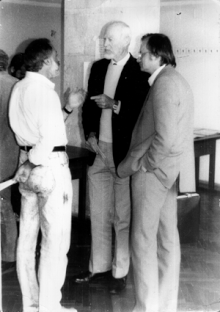Bryce DeWitt
Bryce DeWitt | |
|---|---|
 Bryce with his wife Cécile | |
| Born | Carl Bryce Seligman January 8, 1923 Dinuba, California, U.S. |
| Died | September 23, 2004 (aged 81) Austin, Texas, U.S. |
| Alma mater | Harvard University (PhD) |
| Known for | |
| Spouse | |
| Children | 4 |
| Awards |
|
| Scientific career | |
| Fields | Theoretical physics |
| Institutions | |
| Doctoral advisor | Julian Schwinger |
| Doctoral students | |


Bryce Seligman DeWitt (born Carl Bryce Seligman; January 8, 1923 – September 23, 2004) was an American theoretical physicist noted for his work in gravitation and quantum field theory.[1]
Personal life
He was born Carl Bryce Seligman, but he and his three brothers, including the noted ichthyologist, Hugh Hamilton DeWitt, added "DeWitt" from their mother's side of the family, at the urging of their father, in 1950. In the early-1970s, this change of name so angered Felix Bloch that he blocked DeWitt's appointment to Stanford University and DeWitt and his wife Cecile DeWitt-Morette, a mathematical physicist, accepted faculty positions at the University of Texas at Austin.[2] DeWitt trained in World War II as a naval aviator, but the war ended before he saw combat. He died September 23, 2004, from pancreatic cancer at the age of 81. He is buried in France, and was survived by his wife and four daughters.[3][1]
Academic life
He received his bachelor's (summa cum laude), master's and doctoral degrees from Harvard University. His Ph.D. (1950) supervisor was Julian S. Schwinger, a Nobel Prize-winning american theoretical physicist, best known for his work on quantum electrodynamics (QED). Afterwards, DeWitt held a postdoctoral position at the Institute for Advanced Study in Princeton, New Jersey, and worked at the Lawrence Livermore Lab (1952-'55). Thereafter, he held faculty positions at the University of North Carolina at Chapel Hill (1956-'72) and, later, at the University of Texas at Austin (1973-2004).
In 1957 he and his wife organized the Chapel Hill Conference.[4]
Awards
In 1987 he was awarded the Dirac Prize,[5] the Pomeranchuk Prize in 2002, and, posthumously, the American Physical Society's Einstein Prize in 2005.[6] He also was a member of the National Academy of Sciences.[7]
Work
He pioneered work in the quantization of general relativity and, in particular, developed canonical quantum gravity,[8] manifestly covariant methods, and heat kernel algorithms. DeWitt formulated the Wheeler–DeWitt equation for the wave function of the universe with John Archibald Wheeler and advanced the formulation of Hugh Everett's many-worlds interpretation of quantum mechanics.[1] With his student Larry Smarr, he originated the field of numerical relativity.[9]: 25–35, 37
Books
- Bryce DeWitt, Dynamical theory of groups and fields, Gordon and Breach, New York, 1965
- Bryce DeWitt, R. Neill Graham, eds., The Many-Worlds Interpretation of Quantum Mechanics, Princeton Series in Physics, Princeton University Press (1973), ISBN 0-691-08131-X.
- S. M. Christensen, ed., Quantum theory of gravity. Essays in honor of the 60th birthday of Bryce S. DeWitt, Adam Hilger, Bristol, 1984.
- Bryce DeWitt, Supermanifolds, Cambridge University Press, Cambridge, 1985.
- Bryce DeWitt, The Global Approach to Quantum Field Theory, The International Series of Monographs on Physics, Oxford University Press, 2003, ISBN 978-0-19-851093-2.
- Bryce DeWitt, Sopra un raggio di luce, Di Renzo Editore, Roma, 2005.
- Bryce DeWitt, Bryce DeWitt's Lectures on Gravitation, Steven M. Christensen, ed., Springer, 2011.
References
- ^ a b c Weinberg, Steven (2008). "Bryce Seligman DeWitt 1923-2004: Biographical Memoir" (PDF). nasoline.org. Retrieved October 7, 2023.
- ^ "UTPhysicsHistorySite". Archived from the original on June 20, 2019.
- ^ Family Obituary
- ^ Halpern, Paul (2013). "The Role of the 1957 Chapel Hill Conference in the History of General Relativity". APS April Meeting Abstracts. 2013: T15.006.
- ^ Dirac Prize citation, International Centre for Theoretical Physics
- ^ Einstein Prize citation, American Physical Society
- ^ "DeWitt, Bryce S. (Bryce Seligman), 1923-2004". history.aip.org. Retrieved October 7, 2023.
- ^ DeWitt, Bryce S. (1967). "Quantum Theory of Gravity. I. The Canonical Theory". Physical Review. 160 (5): 1113–1148. doi:10.1103/PhysRev.160.1113.
- ^ DeWitt-Morette, Cécile (2011). "Quantum Gravity". The Pursuit of Quantum Gravity: Memoirs of Bryce DeWitt from 1946 to 2004. Springer. pp. 51–117. ISBN 978-3-642-14270-3.
Further reading
- Deutsch, David; Isham, Christopher; Vilkovisky, Gregory (March 1, 2005). "Bryce Seligman DeWitt". Physics Today. 58 (3): 84–84. doi:10.1063/1.1897570.
- DeWitt-Morette, Cécile (2011). The Pursuit of Quantum Gravity: Memoirs of Bryce DeWitt from 1946 to 2004. Springer. doi:10.1007/978-3-642-14270-3. ISBN 978-3-642-14270-3.
- University of Texas obituary Archived May 11, 2008, at the Wayback Machine
- Oral history interview transcript with Bryce DeWitt and Cecile DeWitt-Morette on February 28 1995, American Institute of Physics, Niels Bohr Library & Archives
